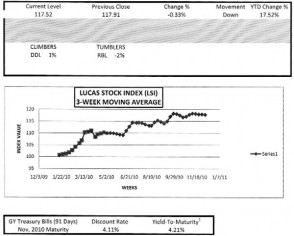Business Model
What do the Bank of Baroda, the Bank of Nova Scotia and Republic Bank have in common, besides being foreign-owned? They like lending to Guyanese consumers. The most recent quarterly statistics from the Bank of Guyana confirm that the three foreign-owned banks operating in Guyana see value in doing business with Guyanese households and have consumer lending as an important part of their business model. The report that covers the quarter ended in September 2010 revealed that the banking sector in Guyana made about 16 percent of its loan portfolio available to Guyanese consumers, even though the disposition in lending vary widely among banks. The contrast between the foreign and local banks is stark and shows the differing approach to utilization of deposits and the strategy for generating future growth in the industry. In the third quarter of 2010, the foreign banks had given an average of 24 percent of their loans to Guyanese households while the local banks had given an average of eight percent.
Double-Digit Shares
All three foreign-owned banks held double-digit shares of their loans to Guyanese families. The biggest support for household financing came from the Bank of Baroda, which used 30 percent of its portfolio on Guyanese households. Republic Bank also set aside a sizable portion of its loan balances for Guyanese consumers, using 27 percent of its loans for that purpose. The Bank of Nova Scotia had over 15 percent of its portfolio in household debt. Despite its relatively small share of the consumer market, it is the one bank that seems interested in milking its assets and deposits with loans and advances. Sixty-six percent of the assets and 77 percent of the deposits of the Bank of Nova Scotia were in the form of loans at the end of September 2010. This is twice as much as each of the other banks, foreign and local, with the exception of Citizens Bank that holds about 45 percent of its assets and 56 percent of its deposits in loans
Firmness
As much as it might reflect a firmness of commitment to Guyanese families by foreign

banks, the third quarter numbers might also be evidence of the declining demand for loans by households. Loan balances to households as a share of total debt were down by 13 percent compared to the last quarter of 2009, at which time the three foreign banks held an average of 25 percent of their portfolio in consumer debt. Leading the way in 2009 was the Bank of Baroda, which held one-third of its loans as household balances. The portfolio was also higher at 16 percent for the Bank of Nova Scotia while Republic Bank held 25 percent of its loans in consumer form. In the third quarter of 2010 as in the fourth quarter of 2009, the consumer loans of the other banks did not exceed eight percent.
Financial Health
There is no doubt that the three foreign-owned banks should be concerned about the structure of their portfolio and how it is managed since the financial performance of these banks changed noticeably between the two quarters in reference. Despite the significant interest in household lending, the favourable results of 2009 were not matched by the performance of 2010.
The last quarter of 2009 saw the return on assets of the foreign banks average 74 cents and the return on equity average $7.56. In both instances, the foreign banks exceeded the industry average and did better than the three locally-owned financial entities which turned in an average return on assets of 61 cents and a return on equity of $5.10. The best performance was recorded by the Bank of Nova Scotia, which chalked up 93 cents on each dollar of asset employed and $8.56 on each dollar of equity invested. Though it did not beat the industry average, the Bank of Baroda did better than both Guyana Bank for Trade and Industry (GBTI) and Citizens Bank by earning 63 cents on every dollar of asset in the process.
Difficult
However, it proved difficult for the foreign-owned banks, as a group, to duplicate or improve upon the performance of the last quarter of 2009. To begin with, the returns did not come easy, even though bank deposits were made to work just as hard in 2010 as in 2009. In trying to keep their returns up in the third quarter of 2010, the foreign-owned banks had to use an average of 47 percent of their deposits to make loans in contrast to the local banks which only used 41 percent of their deposits for loan purposes. This clearly raises questions about the efficiency with which deposits are being used.
The concern is emphasized with the foreign banks being forced to employ 63 percent of their income to meet expenses in the third quarter of 2010. Pushed to use seven percent more income than in 2009, the financial performance of the foreign banks seems to have faltered. This is particularly true for Republic Bank and the Bank of Baroda which saw their return on assets and return on equity plummet by an average of 30 percent in the third quarter of 2010.
Stronger Performance
In contrast, the locally-owned banks exhibited a stronger performance than in 2009. Collectively, they were able to increase their return on assets by 35 percent and to increase their return on equity by 39 percent. They were helped in part by being able to keep more of the income that they earned from loans. The locally-owned banks used 56 percent of their income to cover operational expenses in the third quarter of 2010 as against 58 percent in the last quarter of 2009.
From the foregoing, it is clear that the foreign-owned banks would have to keep a watchful eye on the composition and performance of their portfolio, and any changes do not mean less access to bank loans for Guyanese families.









